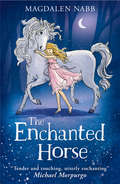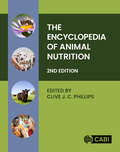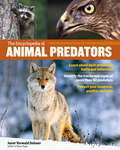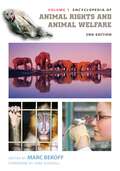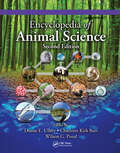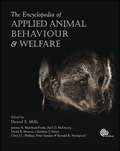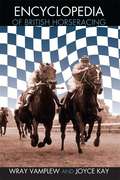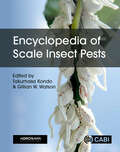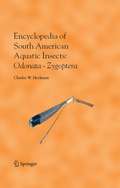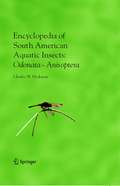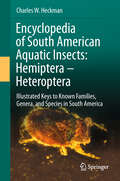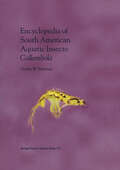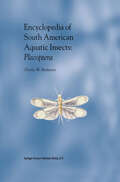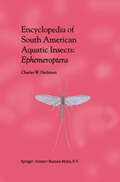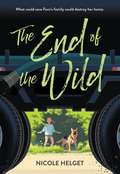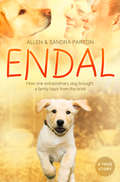- Table View
- List View
The Enchanted Horse (Young Lions Storybook Ser.)
by Magdalen NabbA little toy horse is about to change Irina’s life forever. Award-winning classic young fiction, beautifully illustrated.
The Encyclopedia of Animal Nutrition
by C.J.C. PhillipsThe Encyclopedia of Animal Nutrition covers animal nutrition across a wide range of disciplines, including physiology, biochemistry, veterinary medicine and feed technology. Through approximately 3000 entries ranging from short definitions to more discursive articles, it discusses and illuminates on all aspects of this important topic. The book: - Covers every type of animal managed in developing and developed countries, from livestock and companion animals to those commonly found in laboratories and zoos; - Includes human nutrition as well as fish species used in aquaculture, and farmed invertebrates such as honey bees and prawns, and animals of localised significance such as yaks, snakes, crocodiles, and asses; - Addresses important societal topics in relation to nutrition, including welfare, environmental pollution, disease, resource use, and animal product quality. Written by a global team of contributors and expert section editors, this book is an important resource for researchers, students and advisers of animal nutrition and feed, as well as anyone interested in agriculture, the food industry, veterinary science, zoology, physiology, human health, animal science, and animal behaviour.
The Encyclopedia of Animal Predators: Learn about Each Predator’s Traits and Behaviors; Identify the Tracks and Signs of More Than 50 Predators; Protect Your Livestock, Poultry, and Pets
by Janet Vorwald DohnerThis in-depth guide teaches you how to identify the habits, habitat, method of kill, tracks, and scat of more than 50 of the most common predatory animals, both large and small.
Encyclopedia of Animal Rights and Animal Welfare [2 volumes]: [2 volumes]
A landmark publishing achievement on the subject, the new edition of this acclaimed encyclopedia is expanded to two volumes, covering the full range of issues related to animal protection.Expanded to two volumes, the comprehensively updated new edition, Encyclopedia of Animal Rights and Animal Welfare: Second Edition is an extraordinary publishing event. It remains the only reference to cover the entire scope of animal rights and welfare from a global interdisciplinary perspective, with an international team of contributors assembled by Marc Bekoff covering animal treatment issues in the United States, China, India, Kenya, Australia, and many other nations. With a focused emphasis on fairness and justice for animals evident on every page, Encyclopedia of Animal Rights and Animal Welfare: Second Edition offers clear explanations of hot-button topics like puppy mills, endangered species in zoos, no-kill shelters, dog fighting, factory farming and disease, veganism, conservation ethics, wildlife contraception, and more. The encyclopedia also explores a range of religious, ethical, and philosophical views on using animals, as well as the latest research on animal cognition and sentience. The work helps readers understand the different viewpoints of animal welfare advocates who want to improve conditions for animals and animal rights activists who don't want animals used at all.
Encyclopedia of Animal Science - (Two-Volume Set)
by Duane E. Ullrey, Charlotte Kirk Baer and Wilson G. PondPRINT/ONLINE PRICING OPTIONS AVAILABLE UPON REQUEST AT e-reference@taylorandfrancis.com Containing case studies that complement material presented in the text, the vast range of this definitive Encyclopediaencompasses animal physiology, animal growth and development, animal behavior, animal reproduction and breeding, alternative approaches to animal maintenance, meat science and muscle biology, farmed animal welfare and bioethics, and food safety. With contributions from top researchers in their discipline, the book addresses new research and advancements in this burgeoning field and provides quick and reader-friendly descriptions of technologies critical to professionals in animal and food science, food production and processing, livestock management, and nutrition.
Encyclopedia of Animal Science - (Two-Volume Set)
by Duane E. Ullrey Charlotte Kirk Baer Wilson G. PondPRINT/ONLINE PRICING OPTIONS AVAILABLE UPON REQUEST AT e-reference@taylorandfrancis.com Containing case studies that complement material presented in the text, the vast range of this definitive Encyclopediaencompasses animal physiology, animal growth and development, animal behavior, animal reproduction and breeding, alternative approaches to animal maintenance, meat science and muscle biology, farmed animal welfare and bioethics, and food safety. With contributions from top researchers in their discipline, the book addresses new research and advancements in this burgeoning field and provides quick and reader-friendly descriptions of technologies critical to professionals in animal and food science, food production and processing, livestock management, and nutrition.
The Encyclopedia Of Applied Animal Behaviour And Welfare
by Christina J. Nicol Daniel S. Mills Jeremy N. Marchant-Forde Paul D. McGreevy David B. Morton Clive J. C. Phillips Ronald R. Swaisgood Peter SandøeWelfare research has established a range of scientific indicators of stress, welfare and suffering in animals that can be applied to all aspects of improving their welfare through good housing and management, and the topic continues to grow in importance among both professionals and the public. The practical focus of this authoritative, comprehensive encyclopedia aims to promote the understanding and improvement of animals’ behaviour without compromising welfare. Under the editorial direction of Professor Daniel Mills, the UK’s first specialist in veterinary behavioural medicine, over 180 international experts have contributed a wealth of fully cross-referenced entries from concise definitions to detailed short essays on biological, practical, clinical and ethical aspects of behaviour and welfare in domestic, exotic, companion and zoo animals.
The Encyclopedia Of Applied Animal Behaviour And Welfare
by Christina J. Nicol Daniel S. Mills Jeremy N. Marchant-Forde Paul D. McGreevy David B. Morton Clive J. C. Phillips Ronald R. Swaisgood Peter SandøeWelfare research has established a range of scientific indicators of stress, welfare and suffering in animals that can be applied to all aspects of improving their welfare through good housing and management, and the topic continues to grow in importance among both professionals and the public. The practical focus of this authoritative, comprehensive encyclopedia aims to promote the understanding and improvement of animals' behaviour without compromising welfare. Under the editorial direction of Professor Daniel Mills, the UK's first specialist in veterinary behavioural medicine, over 180 international experts have contributed a wealth of fully cross-referenced entries from concise definitions to detailed short essays on biological, practical, clinical and ethical aspects of behaviour and welfare in domestic, exotic, companion and zoo animals.
Encyclopedia of British Horse Racing (Routledge Sports Reference Series)
by Joyce Kay Professor Wray VamplewThe Encyclopedia of British Horse Racing offers an innovative approach to one of Britain's oldest sports. While it considers the traditional themes of gambling and breeding, and contains biographies of human personalities and equine stars, it also devotes significant space to neglected areas. Entries include: social, economic and political forces that have influenced racing controversial historical and current issues legal and illegal gambling, and racing finance the British impact on world horseracing history and heritage of horseracing links between horse racing and the arts, media and technology human and equine biographies venues associated with racing horseracing websites The Encyclopedia of British Horse Racing provides a unique source of information and will be of great interest to sports historians as well as all those whose work or leisure brings them into the world of racing.
Encyclopedia of British Horse Racing (Routledge Sports Reference Series)
by Wray Vamplew Joyce KayThe Encyclopedia of British Horse Racing offers an innovative approach to one of Britain's oldest sports. While it considers the traditional themes of gambling and breeding, and contains biographies of human personalities and equine stars, it also devotes significant space to neglected areas. Entries include: social, economic and political forces that have influenced racing controversial historical and current issues legal and illegal gambling, and racing finance the British impact on world horseracing history and heritage of horseracing links between horse racing and the arts, media and technology human and equine biographies venues associated with racing horseracing websites The Encyclopedia of British Horse Racing provides a unique source of information and will be of great interest to sports historians as well as all those whose work or leisure brings them into the world of racing.
Encyclopedia of Ecology and Environmental Management
by Peter P. CalowThe Encyclopedia of Ecology and Environmental Management addresses the core definitions and issues in pure and applied ecology. It is neither a short entry dictionary nor a long entry encyclopedia, but lies somewhere in between. The mixture of short entry definitions and long entry essays gives a comprehensive and up-to-date alphabetical guide to over 3000 topics, and allows any subject to be accessed to varying levels of detail; while the longer entries provide general reviews of subjects, the short definitions provide specific details on more specialised areas. An important feature of the Encyclopedia which sets it apart from other similar works is the comprehensive cross-referencing. The most comprehensive and up-to-date reference work in pure and applied ecology. Definitions cover the entire spectrum of pure and applied ecological research. Distinguished editorial board: Dr Peter Moore, Professor John Grace, Professor Bryan Shorrocks, Professor Steven Stearns, Professor Don Falk. International team of distinguished authors - over 200 contributors from 20 countries. 3000 headwords defined. Over 250 long entries review major topics. Heavily illustrated, with a section of colour plates. Complete one volume guide to pure and applied ecology. Presents cutting edge definitions in emerging fields as well as grounding in well-established areas of ecology.
Encyclopedia of Scale Insect Pests
by Jocelyn A. Berry Manuela Branco Lyle Buss Mr Alejandro Caballero Mr Juang Horng Chong Lucía E. Claps C. De Klerk Rodrigo Diaz Imre Foldi Antonio P. Garonna Ilya A. Gavrilov-Zimin Jan H. Giliomee Raymond J. Gill Penny J. Gullan Disna N. Gunawardana Helen Harman Sunil Joshi M. Bora Kaydan Paris L. Lambdin Yen-Po Lin Christopher Malumphy Zvi Mendel Vitor Cezar Pacheco da Silva Giuseppina Pellizzari Ana Lúcia Peronti Francesco Porcelli Alex Protasov Ting-Kui Qin Andrea Amalia Ramos Portilla Dewi Sartiami Scott A. Schneider U.G.A.I. Sirisena Pompeo Suma Éva Szita Hirotaka TanakaScale insects feed on plant juices and can easily be transported to new countries on live plants. They sometimes become invasive pests, costing billions of dollars in damage to crops worldwide annually, and farmers try to control them with toxic pesticides, risking environmental damage. Fortunately, scale insects are highly susceptible to control by natural enemies so biological control is possible. They have unique genetic systems, unusual metamorphosis, a broad spectrum of essential symbionts, and some are sources of commercial products like red dyes, shellac and wax. There is, therefore, wide interest in these unusual, destructive, beneficial, and abundant insects. The Encyclopedia of Scale Insect Pests is the most comprehensive work on worldwide scale insect pests, providing detailed coverage of the most important species (230 species in 26 families, 36% of the scale insect pest species known). Advice is provided on collection, preservation, slide-mounting, vouchering, and labelling of specimens, fully illustrated with colour photographs, diagrams and drawings. Pest species are presented in two informal groups of families, the 'primitive' Archaeococcoids followed by the more 'advanced' Neococcoids, covered in phylogenetic order. Each family is illustrated and diagnosed based on features of live and slide-mounted specimens, with information on numbers of genera and species, main hosts, distribution, and biology. For the important pest species, coverage includes information on the morphology of live and slide-mounted specimens, common names, principal synonyms, geographical distribution, plant hosts, plant damage and economic impact, reproductive biology, dispersal, and management strategies including biological, cultural and chemical control, sterile insect techniques, regulatory control, early warning systems and field monitoring. An additional complete list of scale insect pests worldwide is provided, comprising 642 species in 28 scale insect families (about 8% of the 8373 species of living scales known), with information on plant hosts, geographical distribution and validation sources. Beneficial uses of scale insects include sources of red dyes, natural resins and waxes, and agents for invasive weed control, alongside the importance of their honeydew to bees for making honey, and as a food source to other animals. Academic researchers, students, entomologists, pest management officials in agribusiness or government including plant quarantine identifiers, extensionists, farmers, field scientists and ecologists will all benefit from this book.
Encyclopedia of South American Aquatic Insects: Illustrated Keys to Known Families, Genera, and Species in South America (Encyclopedia of South American Aquatic Insects)
by Charles W. HeckmanThis beautiful volume, with hundreds of fascinating hand-drawn illustrations, completes the two-volume work on the order Odonata in the Encyclopedia of South American Aquatic Insects. The Zygoptera volume encompasses the small dragonflies often called damselflies. The sections on the morphology of the adults and larvae are followed by discussions of factors influencing their distribution and instructions on the methods used to observe, collect, preserve, and examine specimens.
Encyclopedia of South American Aquatic Insects: Illustrated Keys to Known Families, Genera, and Species in South America
by Charles W. HeckmanAnisoptera, the first of two volumes on the Odonata, encompasses the large dragonfly species. To help readers understand naming conventions, a brief introductory biological review of the group includes illustrations of the main morphological features as well as explanations of alternative systems for naming the wing veins and other structures. The text introduces keys to facilitate identification of adult dragonflies and the known larvae. Beyond anatomical features, the keys include the known ranges of the species, synonyms, and citations of literature. The book is richly illustrated with pen and ink drawings of thousands of individual morphological structures.
Encyclopedia of South American Aquatic Insects: Illustrated Keys to Known Families, Genera, and Species in South America (Encyclopedia of South American Aquatic Insects)
by Charles W. HeckmanHemiptera - Heteroptera encompasses the three well-defined suborders of the true bugs which are adapted to an aquatic or littoral habitat. The book begins with a section on the biology these insects and provides illustrations of the basic features of their morphology and outlines the larval development. Brief outlines of the ecological and zoogeographical peculiarities of the three aquatic suborders are presented individually, and various methods for observing, collecting, preserving, rearing, and examining specimens are discussed.Most of the book is devoted to keys for the identification of adults to species, and notes are provided that will help recognize the known larvae. Unlike most other aquatic insects, the larval instars of the heteropteran species closely resemble the adults in their morphology, preferred habitats, and feeding habits. Therefore, distinguishing features of those relatively few larvae which have been described in detail are usually mentioned in the keys to the adults rather than being included in separate keys. In addition to the most important features for determining the individual species, many keys include additional notes on the morphology, which is intended to give the user a better chance of recognizing specimens of species not yet known to science. After the currently recognized name of each species, the known range is provided. Regions of the world outside of South America, South American countries, and the states of Brazil from which the species has been reported are listed. Following the range information, major synonyms previously used for the species in the literature are provided. If subspecies have been described and are still recognized as such, they are also discussed. Finally, if the status of the species is regarded as uncertain because of a poor description, strong resemblance to another species, or any other reason, a note is added that a detailed study will be necessary to clarify the status of the taxon. Taxonomic revisions in the book itself are strictly avoided.To provide the user of the keys with maximum assistance in making reliable identifications, the book is richly illustrated with pen and ink drawings of thousands of individual morphological structures arranged in 820 figures. The book is intended to make a significant impact toward popularizing the study of South American water bugs by assembling and condensing the information in hundreds of individual publications on the group, which appeared in many books and journals published in many different countries over the past 200 years. Some of these works are very difficult to obtain in South America, and their lack creates serious impediments to systematic, ecological, and zoogeographical research. In the more than 730 titles appearing in the bibliography, the original descriptions and revisions of almost all South American species can be found.
Encyclopedia of South American Aquatic Insects: Illustrated Keys to Known Families, Genera, and Species in South America (Encyclopedia of South American Aquatic Insects)
by Charles W. HeckmanThis work was begun to provide keys to the aquatic insect species known from Brazil. The original goal was to include all genera known from South America and all species from Brazil, but for most groups, the scope was expanded to encompass all species in South America, and, in many cases, to include terrestrial species of orders that include both terrestrial and aquatic taxa. In no case is a taxonomic reVlSlon of any group undertaken, although recommendations for such revisions are included, and the probable synonymy of nominal species still treated as valid in the literature is noted. Two different approaches are employed according to the taxon being treated. For phylogenetic groups encompassing overwhelmingly or exclusively aquatic species, such as the orders Odonata and Ephemeroptera or the families Dytiscidae and Culicidae, keys are provided to distinguish all genera and species known to occur in South America. An effort has been made to include every identifiable species so that the user of the key can determine with reasonable certainty whether or not his specimen belongs to a species that has already been described or whether it is one that is not yet known to science.
Encyclopedia of South American Aquatic Insects: Illustrated Keys to Known Families, Genera, and Species in South America (Encyclopedia of South American Aquatic Insects)
by Charles W. HeckmanThis work was begun to provide keys to the aquatic insect species known from Brazil. The original goal was to include all genera known from South America and all species from Brazil, but for most groups, the scope was expanded to encompass all species in South America, and, in some cases, to include terrestrial species of orders comprising both terrestrial and aquatic taxa. In no case is a taxonomic rev1s10n of any group undertaken, although recommendations for such revisions are included where appropriate, and probable synonymy of nominal species still treated as valid in the literature is noted. Two different approaches will be employed according to the taxon being treated. For phylogenetic groups encompassing overwhelmingly or exclusively aquatic species, such as the orders Plecoptera and Ephemeroptera or the families Dytiscidae and Culicidae, keys are provided to distinguish all genera and species known to occur in South America. An effort has been made to include every identifiable species so that the user of the key can determine with reasonable certainty whether or not his specimen belongs to a species that has already been described or whether it is one that is not yet known to science. Where feasible, complete keys will be prepared for groups containing both aquatic and terrestrial species that do not encompass an extraordinarily large number of species. This has already been done for the order Collembola.
Encyclopedia of South American Aquatic Insects: Illustrated Keys to Known Families, Genera, and Species in South America
by Charles W. HeckmanThis work was begun to provide keys to the aquatic insect species known from Brazil. The original goal was to include all genera known from South America and all species from Brazil, but for most groups, the scope was expanded to encompass all species in South America, and, in some cases, to include terrestrial species of orders comprising both terrestrial and aquatic taxa. In no case is a taxonomic revision of any group undertaken, although recommendations for such revisions are included where appropriate, and probable synonymy of nominal species still treated as valid in the literature is noted. Two different approaches will be employed according to the taxon being treated. For phylogenetic groups encompassing overwhelmingly or exclusively aquatic species, such as the orders Plecoptera and Ephemeroptera or the families Dytiscidae and Culicidae, keys are provided to distinguish all genera and species known to occur in South America. An effort has been made to include every identifiable species so that the user ofthe key can determine with reasonable certainty whether or not his specimen belongs to a species that has already been described or whether it is one that is not yet known to science. Where feasible, complete keys will be prepared for groups containing both aquatic and terrestrial species that do not encompass an extraordinarily large number ofspecies. This has already been done for the order Collembola.
The End of Eden: Wild Nature in the Age of Climate Breakdown
by Adam Welz“Exquisite.”-DAVID WALLACE-WELLS “At once an elegy and an exhortation.”-ELIZABETH KOLBERT “A book that goes deeper than any before into the meaning of the climate breakdown for all the rest of creation.”-BILL McKIBBEN “Celebratory and heartbreaking.”-DAVID GEORGE HASKELLA revelatory exploration of climate change from the perspective of wild species and natural ecosystems--an homage to the miraculous, vibrant entity that is life on Earth. The stories we usually tell ourselves about climate change tend to focus on the damage inflicted on human societies by big storms, severe droughts, and rising sea levels. But the most powerful impacts are being and will be felt by the natural world and its myriad species, which are already in the midst of the sixth great extinction. Rising temperatures are fracturing ecosystems that took millions of years to evolve, disrupting the life forms they sustain--and in many cases driving them towards extinction. The natural Eden that humanity inherited is quickly slipping away. Although we can never really know what a creature thinks or feels, The End of Eden invites the reader to meet wild species on their own terms in a range of ecosystems that span the globe. Combining classic natural history, firsthand reportage, and insights from cutting-edge research, Adam Welz brings us close to creatures like moose in northern Maine, parrots in Puerto Rico, cheetahs in Namibia, and rare fish in Australia as they struggle to survive. The stories are intimate yet expansive and always dramatic. An exquisitely written and deeply researched exploration of wild species reacting to climate breakdown, The End of Eden offers a radical new kind of environmental journalism that connects humans to nature in a more empathetic way than ever before and galvanizes us to act in defense of the natural world before it's too late.
The End of Eden: Wild Nature in the Age of Climate Breakdown
by Adam Welz“At once an elegy and an exhortation.”-ELIZABETH KOLBERT A revelatory exploration of climate change from the perspective of wild species and natural ecosystems - an homage to the miraculous, vibrant entity that is life on Earth.The stories we usually tell ourselves about climate change tend to focus on the damage inflicted on human societies by big storms, severe droughts, and rising sea levels. But the most powerful impacts are being and will be felt by the natural world and its myriad species, which are already in the midst of the sixth great extinction. Rising temperatures are fracturing ecosystems that took millions of years to evolve, disrupting the life forms they sustain - and in many cases driving them towards extinction. The natural Eden that humanity inherited is quickly slipping away.Although we can never really know what a creature thinks or feels, The End of Eden invites the reader to meet wild species on their own terms in a range of ecosystems that span the globe. Combining classic natural history, firsthand reportage, and insights from cutting-edge research, Adam Welz brings us close to creatures like moose in northern Maine, parrots in Puerto Rico, cheetahs in Namibia, and rare fish in Australia as they struggle to survive. The stories are intimate yet expansive and always dramatic.An exquisitely written and deeply researched exploration of wild species reacting to climate breakdown, The End of Eden offers a radical new kind of environmental journalism that connects humans to nature in a more empathetic way than ever before and galvanizes us to act in defense of the natural world before it's too late.
The End of the End of the Earth: Essays
by Jonathan FranzenA sharp and provocative new essay collection from the award-winning author of Freedom and The Corrections
The End of the Wild
by Nicole HelgetThis timely coming of age novel takes on the controversial issues of fracking and environmental protection.Stay away from my woods.Eleven-year-old Fern doesn't have the easiest life. Her stepfather is out of work, and she's responsible for putting dinner on the table--not to mention keeping her wild younger brothers out of trouble. The woods near their home is her only refuge, where she finds food and plays with her neighbor's dog. But when a fracking company rolls into town, her special grove could be ripped away, and no one else seems to care.Her stepfather needs the money that a job with the frackers could bring to their family, and her wealthy grandfather likes the business it brings to their town. Even her best friend doesn't understand what the land means to Fern. With no one on her side, how can she save the forest that has protected her for so long?The acclaimed author of Wonder at the Edge of the World weaves a poignant story about life on the poverty line, the environment, friendship and family--and, most of all, finding your place in the world.
Endal: How One Extraordinary Dog Brought A Family Back From The Brink
by Allen Parton Sandra PartonThe remarkable story of Endal, voted ‘Dog of the Millennium’, and how, through his remarkable skills, companionship and unstinting devotion, he gave Allen Parton a reason to live again.
